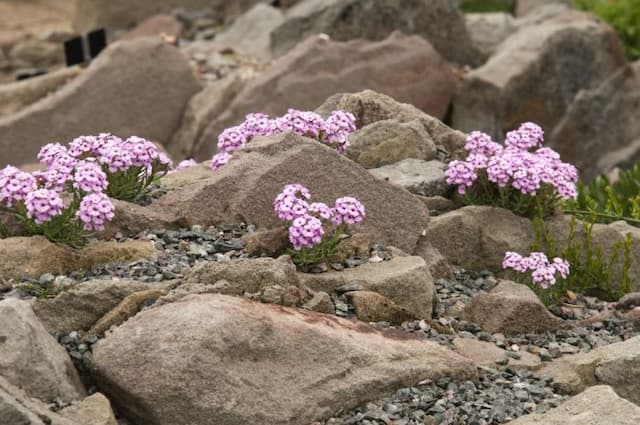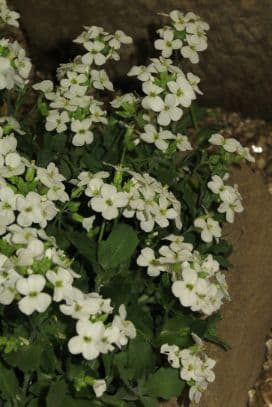Rock Cress Aubrieta 'Red Cascade' (Cascade Series)

ABOUT
Aubrieta 'Red Cascade' is a charming flowering plant known for its vibrant floral display and lush foliage. The color palette of Red Cascade is dominated by its striking, deep red-purple flowers that make a dramatic statement when in bloom. These small, four-petalled flowers cluster together in a profuse mat-like formation, providing a rich tapestry of color. The blooms contrast exquisitely with the plant's foliage, which consists of small, oval to spoon-shaped leaves. The leaves are typically a soft green, sometimes with a greyish hue, and they create a dense, low-growing groundcover effect. This ornamental plant is appreciated for its ability to spill over and soften edges, whether growing over rock walls, cascading down a slope, or edging a path. Its growth habit gives the impression of a lush, colorful waterfall of flowers, hence the association with the term "cascade" in its name. Overall, Aubrieta 'Red Cascade' is admired for its dense floral display and its ability to add a vivid splash of color to garden settings.
About this plant
 Names
NamesFamily
Brassicaceae
Synonyms
False Rockcress, Rock Cress, Purple Rock Cress
Common names
Aubrieta 'Red Cascade' (Cascade Series).
 Toxicity
ToxicityTo humans
Aubrieta, commonly known as Rock Cress, is generally considered non-toxic to humans. There are no significant toxic effects reported for humans from ingesting this plant.
To pets
Rock Cress is also typically safe and non-toxic for pets. It is not known to cause any significant symptoms of poisoning if pets ingest this plant.
 Characteristics
CharacteristicsLife cycle
Perennials
Foliage type
Evergreen
Color of leaves
Green
Flower color
Purple
Height
4-6 inches (10-15 cm)
Spread
18-24 inches (45-60 cm)
Plant type
Creeper
Hardiness zones
4
Native area
Mediterranean
Benefits
 General Benefits
General Benefits- Aesthetic Appeal: Aubrieta 'Red Cascade' adds vibrant color with its red-purple flowers during spring, enhancing the visual appeal of gardens and landscapes.
- Ground Cover: It is an excellent ground cover that can help reduce soil erosion and suppress weed growth.
- Low Maintenance: Once established, it requires minimal care, making it ideal for gardeners looking for low-maintenance options.
- Attracts Pollinators: The bright flowers attract bees and butterflies, supporting local ecosystems and pollination.
- Rock Gardens: It is well-suited for rock gardens and crevices where it can naturalistically cascade and add depth to the planting area.
- Drought Tolerant: Aubrieta 'Red Cascade' is fairly drought-resistant, making it suitable for dry and xeriscape gardens.
- Seasonal Interest: The plant's spring flowering period provides a burst of seasonal interest after a long winter.
- Edging Plant: It can be used effectively as an edging plant along paths or garden borders.
- Alpine and Perennial: As part of the Cascade Series, it's well-suited for alpine and perennial beds where it can thrive year after year.
- Container Gardening: It is suitable for growing in containers on patios or balconies where ground space is limited.
 Medical Properties
Medical PropertiesThis plant is not used for medical purposes.
 Air-purifying Qualities
Air-purifying QualitiesThis plant is not specifically known for air purifying qualities.
 Other Uses
Other Uses- Aubrieta can serve as a natural dye, providing shades of blue and purple extracted from the flowers for fabric coloring.
- Floristry: The plant's vibrant cascading flowers are sometimes used in floral arrangements for an added burst of color.
- Photography backdrop: Aubrieta's lush blankets of flowers are popular among photographers looking for a vibrant, natural backdrop.
- Educational tool: Horticulture students can study Aubrieta as an example of a plant that thrives in alpine conditions and rock gardens.
- Art inspiration: Artists may use Aubrieta as a subject for paintings, drawings, and other art forms due to its striking appearance.
- Ecological studies: It can be a subject for ecological research, especially in understanding ground cover plants' roles in preventing soil erosion.
- Culinary decoration: While not commonly consumed, the blossoms can be used as edible decorations on cakes and deserts for a touch of color.
- Fairy gardens: Due to its miniature size and cascading growth habit, the plant is ideal for creating whimsical fairy garden landscapes.
- Container gardening experiments: Gardeners might use Aubrieta to experiment with different container styles and soil mixes.
- Seed harvesting: Enthusiast gardeners can practice seed collection and storage from Aubrieta as it's relatively easy to collect seeds once the blooms have faded.
Interesting Facts
 Feng Shui
Feng ShuiThe Aubrieta is not used in Feng Shui practice.
 Zodiac Sign Compitability
Zodiac Sign CompitabilityThe Aubrieta is not used in astrology practice.
 Plant Symbolism
Plant Symbolism- Determination: Aubrieta 'Red Cascade' grows vigorously and can spread across rock faces and tough environments, symbolizing the ability to thrive in challenging conditions.
- Energy: The vibrant red blossoms of this plant embody vitality and dynamic energy, making it a symbol for an enthusiastic approach to life.
- Survival: Known for its hardiness, Aubrieta represents survival and the perseverance to withstand adverse situations.
- Growth: As a groundcover plant that expands quickly, Aubrieta signifies personal growth and the rapid expansion of ideas or projects.
 Water
WaterRock cress, including the Aubrieta 'Red Cascade', prefers well-drained soil and should be watered deeply but infrequently. During the active growing season in spring and early summer, watering should typically occur once a week, allowing soil to dry out slightly between watering sessions. Approximately one gallon per plant per watering session is sufficient. However, during particularly hot or dry weather, increase the frequency to ensure the soil doesn't dry out completely. In fall and winter, reduce watering as the plant goes dormant and requires less moisture.
 Light
LightRock cress thrives in full sun conditions, making it best suited for a spot where it receives at least six hours of direct sunlight a day. The high light intensity brings out the best in its flowering ability. If it's placed in too much shade, the plant may not bloom as vigorously and can become leggy.
 Temperature
TemperatureRock cress is a hardy plant that can withstand a range of temperatures, with general survival between 32°F and 80°F. However, it prefers temperate conditions and thrives between 60°F and 75°F, making it ideal for spring and fall growth. It can tolerate some frost but sustained extreme cold or heat beyond these ranges can damage the plant.
 Pruning
PruningPruning rock cress is important to maintain its compact, mounded shape and to encourage vibrant blooms. Immediately after flowering, typically in late spring or early summer, prune back the spent flowers and about a third of the plant's growth to stimulate new buds and to refresh the plant. Annual pruning ensures the best display the following season.
 Cleaning
CleaningAs needed
 Soil
SoilRock cress thrives in a well-draining, loamy or sandy soil with a neutral to slightly alkaline pH, typically between 6.5 to 7.5. A mix containing one-third each of potting soil, sharp sand, and fine gravel or perlite can create the ideal growing conditions for this alpine plant.
 Repotting
RepottingRock cress, being a low maintenance perennial, doesn't require frequent repotting and generally only needs it every 2 to 3 years or if it outgrows its container.
 Humidity & Misting
Humidity & MistingRock cress prefers a dry climate and can tolerate low humidity conditions, making it well-adapted for rock gardens and arid environments.
 Suitable locations
Suitable locationsIndoor
Keep in bright light, limit watering, and ensure good airflow.
Outdoor
Plant in full sun, well-drained soil, and water sparingly.
Hardiness zone
4-9 USDA
 Life cycle
Life cycleAubrieta 'Red Cascade', also known simply as Red Cascade Rock Cress, begins its life cycle with seed germination, which occurs in late winter to early spring under the right conditions of moisture and temperature. After germination, the seedlings grow rapidly, establishing a mat-like foliage of small, oval green leaves. As the plant matures, it enters a vegetative stage where it spreads out to form a dense, low carpet that is particularly well-suited for rock gardens and ground cover. The flowering stage follows in mid to late spring, showcasing vibrant red-violet blossoms that attract pollinators such as bees and butterflies. After pollination, the flowers develop into small seed pods that eventually release seeds, allowing for the natural propagation of the next generation. Over the winter months, the plant goes dormant, retreating back to the ground level to conserve energy for the next growing season.
 Propogation
PropogationPropogation time
Spring to Summer
The most popular method for propagating the Aubrieta 'Red Cascade' is through stem cuttings. This process usually takes place in late spring to early summer when the plant is actively growing. To perform this method, select a healthy stem that has new growth but is not too tender. Cut a 3 to 4-inch (approximately 7.5 to 10 cm) segment from the stem, ensuring that there are a few leaves present. Remove the lower leaves to expose a couple of nodes where roots will form. The cutting should be planted in well-draining soil, and kept moist but not waterlogged. To create a humid environment, you can cover the cutting with a plastic bag or place it in a propagator, ensuring that there is some air circulation to prevent rot. Roots usually develop within a few weeks, after which the new plant can be gradually acclimatized to less humid conditions before planting it out.



![Aubrieta [Axcent Light Blue]](/_next/image?url=https%3A%2F%2Fplants-admin.emdemapps.com%2Fimages%2Fplants%2F%2Fimages%2F604b5e7128866.png&w=640&q=75)





